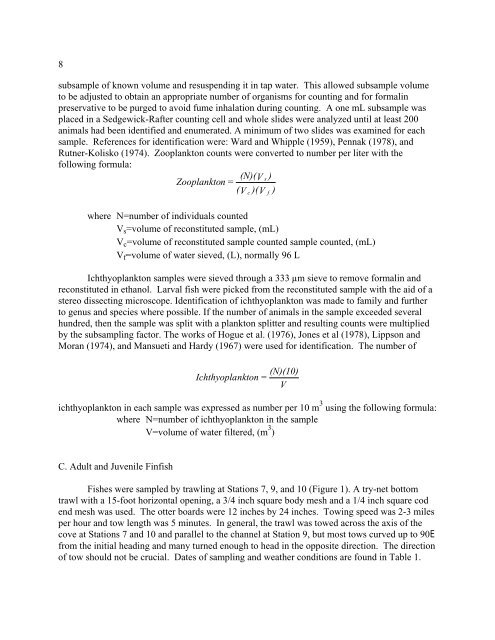NEW: Annual Report - George Mason University
NEW: Annual Report - George Mason University
NEW: Annual Report - George Mason University
You also want an ePaper? Increase the reach of your titles
YUMPU automatically turns print PDFs into web optimized ePapers that Google loves.
8<br />
subsample of known volume and resuspending it in tap water. This allowed subsample volume<br />
to be adjusted to obtain an appropriate number of organisms for counting and for formalin<br />
preservative to be purged to avoid fume inhalation during counting. A one mL subsample was<br />
placed in a Sedgewick-Rafter counting cell and whole slides were analyzed until at least 200<br />
animals had been identified and enumerated. A minimum of two slides was examined for each<br />
sample. References for identification were: Ward and Whipple (1959), Pennak (1978), and<br />
Rutner-Kolisko (1974). Zooplankton counts were converted to number per liter with the<br />
following formula:<br />
Zooplankton<br />
=<br />
(N)( V s )<br />
c )( V f )<br />
where N=number of individuals counted<br />
Vs=volume of reconstituted sample, (mL)<br />
Vc=volume of reconstituted sample counted sample counted, (mL)<br />
Vf=volume of water sieved, (L), normally 96 L<br />
( V<br />
Ichthyoplankton samples were sieved through a 333 µm sieve to remove formalin and<br />
reconstituted in ethanol. Larval fish were picked from the reconstituted sample with the aid of a<br />
stereo dissecting microscope. Identification of ichthyoplankton was made to family and further<br />
to genus and species where possible. If the number of animals in the sample exceeded several<br />
hundred, then the sample was split with a plankton splitter and resulting counts were multiplied<br />
by the subsampling factor. The works of Hogue et al. (1976), Jones et al (1978), Lippson and<br />
Moran (1974), and Mansueti and Hardy (1967) were used for identification. The number of<br />
(N)(10)<br />
Ichthyopla nkton =<br />
V<br />
ichthyoplankton in each sample was expressed as number per 10 m 3 using the following formula:<br />
where N=number of ichthyoplankton in the sample<br />
V=volume of water filtered, (m 3 )<br />
C. Adult and Juvenile Finfish<br />
Fishes were sampled by trawling at Stations 7, 9, and 10 (Figure 1). A try-net bottom<br />
trawl with a 15-foot horizontal opening, a 3/4 inch square body mesh and a 1/4 inch square cod<br />
end mesh was used. The otter boards were 12 inches by 24 inches. Towing speed was 2-3 miles<br />
per hour and tow length was 5 minutes. In general, the trawl was towed across the axis of the<br />
cove at Stations 7 and 10 and parallel to the channel at Station 9, but most tows curved up to 90E<br />
from the initial heading and many turned enough to head in the opposite direction. The direction<br />
of tow should not be crucial. Dates of sampling and weather conditions are found in Table 1.
















